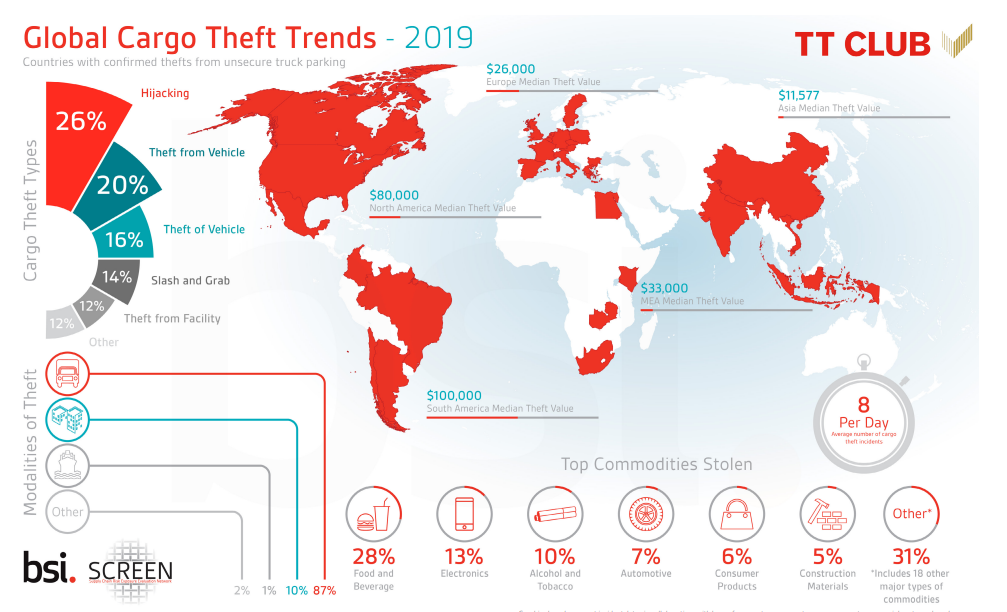The transport and logistic insurer TT Club along with the global provider BSI issued the “Cargo Theft Report 2020” highlighting the impact of cargo theft on the global supply chain, while giving its recommendations of how theft risks can be reduced.
During 2019, both organizations marked several key trends concerning cargo theft incidents. In fact, these trends include both the enormous targeting of cargo trucks for theft in comparison to all other modalities as wells as the food and beverage industry which marked the most theft incidents.
Thefts either of, or from road vehicles most frequently occurred while in transit, in rest areas or an unsecured parking location. These accounted for 60% of those thefts reported. The median value of losses from these incidents ranges from US$100,000 in South America to just over US$11,000 in parts of Asia.
…said TT Club’s Mike Yarwood.
Cargo theft-Key trends:
- Concerning Asia, BSI and TT Club most frequently reported cargo thefts in India and China. In fact, the methods used by the cargo thieves in both regions, range from very opportunistic means, such as pilferage and thefts by drivers or passersby, to more disorganize tactics, including in-transit truck thefts. Unlike in 2018, in which metal ranked second for top commodities stolen, an increase in thefts of electronics and construction materials was seen, while metal fell to fifth overall during 2019. In both years, food and beverage ranked first as the top commodity stolen in Asia.
- For another year in-a-row, the lack of secure parking for cargo trucks influence cargo theft trends in Europe. United Kingdom and Germany lack a sufficient amount of secure parking locations, making it easier for thieves. Regulations that limit the length that cargo truck drivers can operate before taking a mandatory break also exacerbates the lack of secure parking and often forces drivers to stop in vulnerable locations.
- During 2019, BSI and TT Club recorded cargo truck hijackings as the primary theft type in the Middle East and Africa, similarly to 2018 in which cargo truck hijackings also led as the primary type of theft in this region.
- Once again, North America continues to be split among two types of theft, concerning reserved thefts of unattended cargo trucks in the United States and Canada and often violent, hijackings characteristic of Mexico and Central America.
- No other region globally faces with the the highest rate of cargo truck hijackings than the South America. During 2019 in Brazil, BSI and TT Club recorded the overwhelming majority of theft incidents. At the same time, Argentina, Peru, and Chile, also tend to see frequent cargo truck hijacking incidents.

In 2019 BSI and TT Club observed a decrease in the number of cargo truck hijacking incidents, with slash and grab and thefts from vehicles rising in frequency this year compared to last.
Conclusions:
- Thefts more frequently occurred at unsecure rest areas in 2019 instead of taking place while vehicles were in transit.
- Europe is arguably the leading region for which the lack of secure parking for cargo trucks influence cargo theft trends.
- All major countries in the region lack enough secure parking locations, creating ample and easy opportunities for thieves to strike.
- Vehicle parking locations should have adequate physical security barriers (perimeter fence) so that all vehicles are naturally funneled in and out of a managed and controlled vehicle access point.
- All access points for vehicles entering or leaving the parking area should be controlled physically by a secure barrier and/or a lockable gate.
- The access points should be managed appropriately to ensure all vehicles and drivers are checked and validated prior to entry/exit and no unauthorized vehicles can access the parking area.
- Appropriate CCTV systems should be deployed that can monitor vehicle and pedestrian activities along the perimeter, outside approaching roads and specifically at the points of access into the facility covering vehicles entering and exiting.
Explore more herebelow


































































